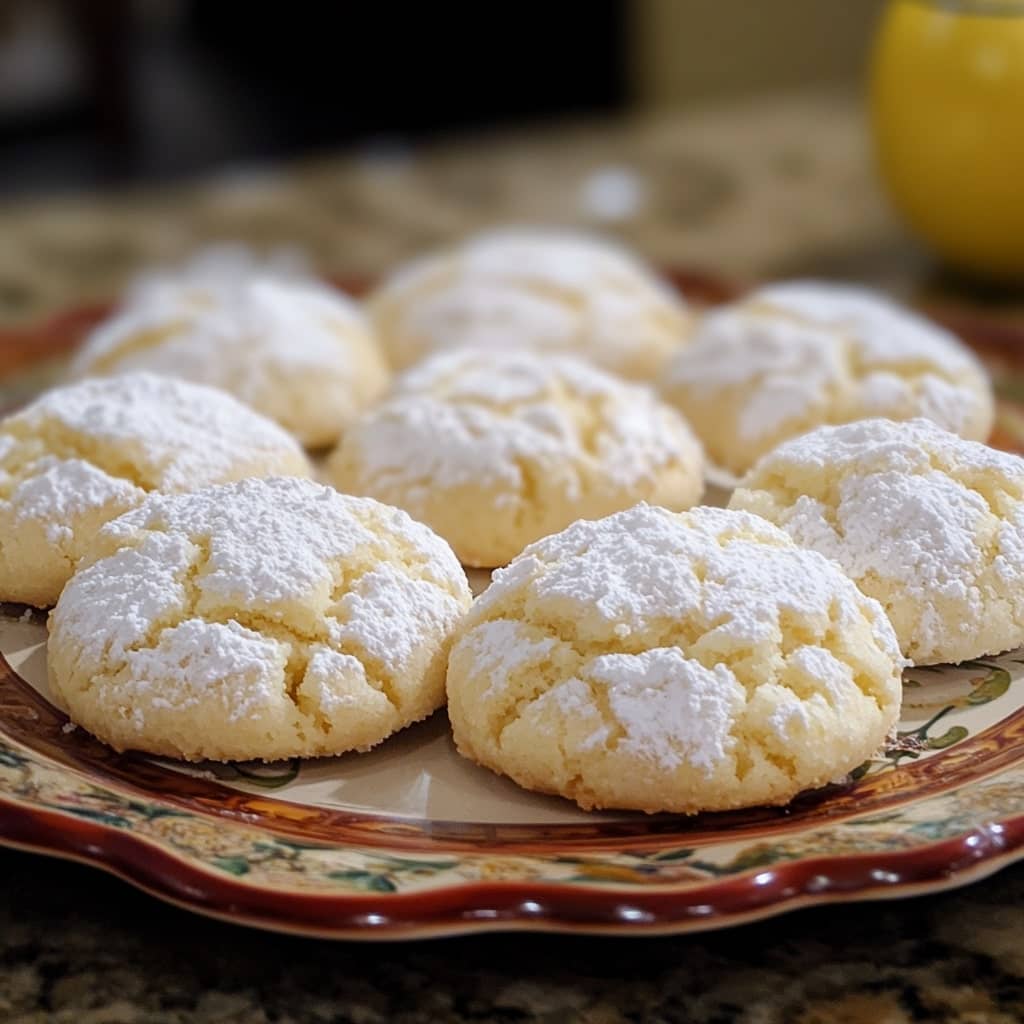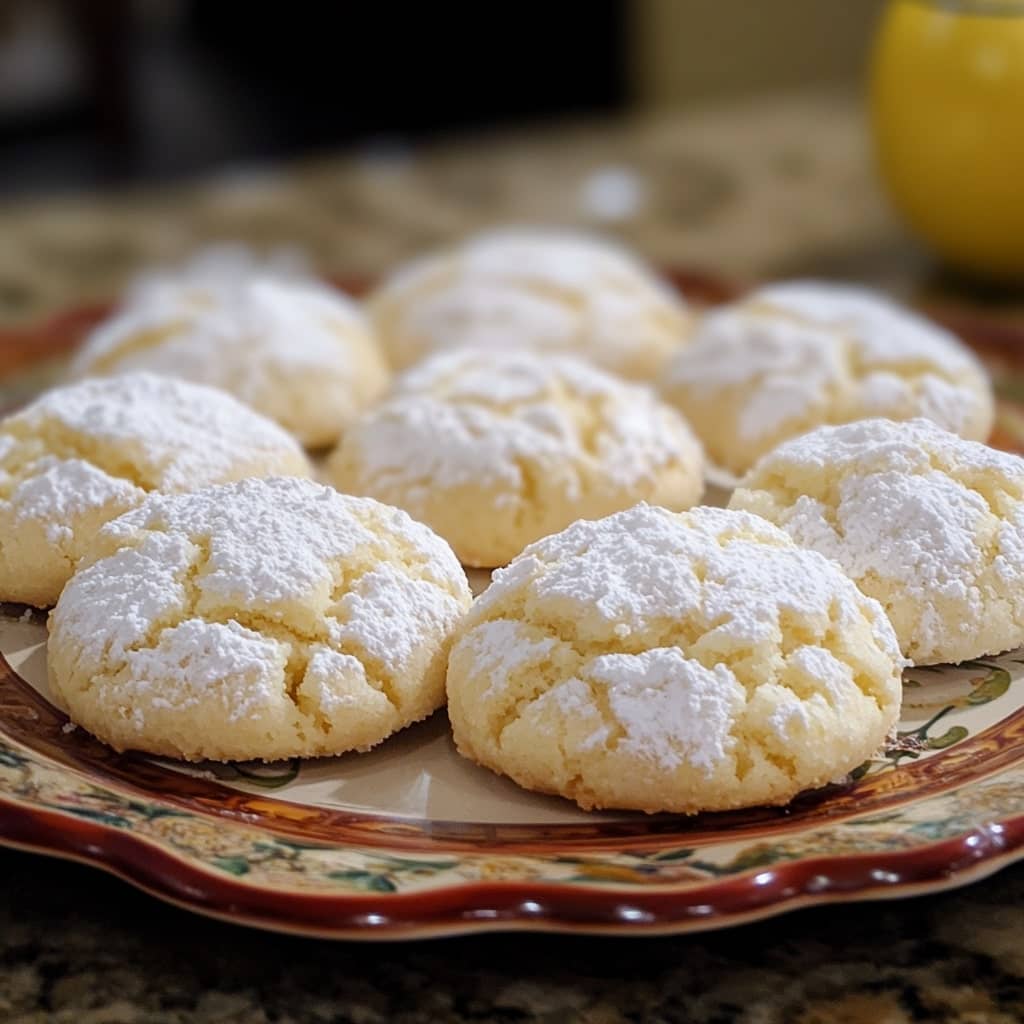Italian Lemon Drop Cookies, known in some regions as “Anginetti” or “Taralli al Limone,” are a delightful and zesty treat beloved across Italian households, especially during holidays, weddings, and special celebrations. Their delicate lemon flavor, paired with a soft, cake-like texture and a light glaze, makes them a refreshing dessert or snack enjoyed by both children and adults. These cookies are not only a nostalgic comfort food for many Italians but also a symbol of hospitality, often served with coffee or tea. Their simplicity and bright citrus taste reflect the essence of Mediterranean baking traditions, where natural flavors and family recipes play a vital role.
The History of Italian Lemon Drop Cookies
Italian Lemon Drop Cookies have deep roots in Southern Italy, particularly in regions like Campania and Calabria, where lemon trees flourish thanks to the warm climate and fertile volcanic soil. Lemons are central to many Southern Italian dishes, from savory to sweet, and their zest and juice are prized for adding vibrant flavor without overwhelming sweetness. These cookies likely evolved from more general Italian drop cookie traditions, with the lemon twist becoming popular as citrus cultivation spread. In immigrant communities, particularly among Italian-Americans, the cookies became a staple in holiday baking trays and cookie exchanges. Over time, variations have emerged, with some families adding almond extract, anise, or different glazes, though the classic lemon flavor remains the most cherished.
Ingredients Breakdown
The essential ingredients for Italian Lemon Drop Cookies include: all-purpose flour, which provides the structural base; baking powder, which gives the cookies their characteristic puff and light texture; salt, to balance sweetness and enhance flavor; unsalted butter or sometimes oil, which contributes to richness and moisture; granulated sugar for sweetness; large eggs, acting as a binder and adding a light, airy consistency; fresh lemon zest and lemon juice, which infuse the dough with a bright citrus note; vanilla extract for depth; and powdered sugar mixed with more lemon juice for the glaze. Optional ingredients may include milk (to adjust dough consistency), almond extract (for a nutty undertone), or food coloring if preparing them for festive occasions.
Step-by-Step Recipe
- Preheat your oven to 350°F (175°C) and line baking sheets with parchment paper.
- In a medium bowl, whisk together 3 cups of all-purpose flour, 2½ teaspoons of baking powder, and ¼ teaspoon of salt. Set aside.
- In a large mixing bowl, cream ½ cup (1 stick) of unsalted butter and ¾ cup of granulated sugar until light and fluffy. This may take about 2–3 minutes using an electric mixer.
- Add 3 large eggs one at a time, beating well after each addition. Mix in 1 teaspoon of vanilla extract, 1 tablespoon of lemon zest, and 2 tablespoons of fresh lemon juice.
- Gradually add the dry ingredients to the wet ingredients, mixing just until incorporated. If the dough seems too sticky, add an extra tablespoon or two of flour until it becomes workable.
- Using a small cookie scoop or tablespoon, drop rounded portions of dough onto the prepared baking sheets, spacing them about 2 inches apart.
- Bake for 10–12 minutes, or until the bottoms are lightly golden but the tops remain pale and puffy. Do not overbake.
- Remove from the oven and let cookies cool on the pan for 5 minutes before transferring to a wire rack to cool completely.
- Meanwhile, prepare the glaze by whisking together 1 cup of powdered sugar with 2–3 tablespoons of fresh lemon juice until smooth and slightly runny.
- Dip the tops of the cooled cookies into the glaze or spoon it over them. Let the glaze set before serving. You can also top with sprinkles for added color and festivity.
Tips for the Perfect Italian Lemon Drop Cookies
Use fresh lemons for both zest and juice to ensure the most vibrant flavor—bottled juice doesn’t compare. Be careful not to overmix the dough once the flour is added, as this can make the cookies tough. The dough should be slightly sticky but not too wet; chilling it for 15–30 minutes can make it easier to handle if necessary. Don’t overbake the cookies—aim for a soft, cake-like texture, which means removing them while the tops are still pale. When glazing, allow cookies to cool completely to prevent the glaze from melting. For an extra punch of lemon, you can add a few drops of lemon extract to the dough or glaze. Use a microplane for the lemon zest to maximize oils and fragrance without including the bitter white pith.
Variations and Customizations
While the classic version highlights lemon, you can experiment with other citrus fruits like orange or lime for a different twist. Almond extract or anise extract can be added for a more traditional Southern Italian flavor profile. For a festive look, top glazed cookies with colored nonpareils or sanding sugar. Some versions swap out butter for vegetable oil, resulting in an even softer texture and slightly different flavor. You can also sandwich two cookies together with lemon curd or a citrus-flavored cream for an elegant dessert. Another fun variation is dipping half the cookie in white or dark chocolate after glazing. For a dairy-free version, substitute margarine or oil and ensure any glaze components are free from milk products.
Health Considerations and Nutritional Value
Italian Lemon Drop Cookies are a treat and should be enjoyed in moderation. Each cookie contains around 100–150 calories depending on size and ingredients, primarily from carbohydrates and fat. Using butter gives them saturated fat, though some recipes use oil to reduce this. While lemons provide vitamin C and antioxidants, the amounts used in cookies are minimal nutritionally. You can make them slightly healthier by reducing sugar, using whole wheat flour for part of the all-purpose flour, or using unsweetened applesauce in place of some butter. For people with food sensitivities, they can be made gluten-free with a flour blend and dairy-free with oil or plant-based margarine. These cookies are not suitable for keto or low-carb diets in their traditional form, but a modified recipe using almond flour and erythritol could work.
FAQ
Q: Can I freeze Italian Lemon Drop Cookies? Yes, you can freeze them before glazing for up to 3 months. Thaw and glaze when ready to serve.
Q: How long do they stay fresh? Stored in an airtight container, they last about 5–7 days at room temperature.
Q: Can I use bottled lemon juice? It’s not recommended due to its processed taste; fresh juice provides the best flavor.
Q: Why are my cookies too dense or dry? Overmixing or overbaking can lead to dryness. Be sure to follow time and mixing guidelines.
Q: Can I skip the glaze? Yes, but the glaze adds sweetness and enhances the lemon flavor—if you skip it, consider adding extra sugar to the dough.
Q: Can I make them vegan? Yes, substitute eggs with flaxseed meal or applesauce and use plant-based butter or oil.
Q: Are they the same as Italian wedding cookies? No, Italian wedding cookies are nut-based and crumbly, while lemon drop cookies are soft and cakey.

Italian Lemon Drop Cookies
Ingredients
Method
- Preheat the Oven: Set your oven to 375°F and prepare cookie sheets by lining them with parchment paper or silicone baking mats.
- Prepare the Dry Ingredients: In a medium bowl, whisk together 2 cups of all-purpose flour, 1 tablespoon of baking powder, and ½ teaspoon of salt. Set aside for later use.
- Cream the Butter and Sugar: In a large mixing bowl, beat ¼ cup of unsalted butter and ½ cup of granulated sugar using an electric mixer for about 1 minute, or until the mixture becomes pale and fluffy.
- Add the Wet Ingredients: Add 1 large egg and ¼ teaspoon of vanilla extract to the butter mixture and beat until fully combined. Then mix in 2 tablespoons of fresh lemon juice and 1 tablespoon of lemon zest.
- Combine Wet and Dry Ingredients: Slowly incorporate the dry ingredients into the wet mixture in two additions, alternating with ⅓ cup of milk. Begin with half the dry mix, stir in the milk, then add the remaining dry ingredients. The finished dough should be thick and sticky.
- Scoop the Dough: Using a small cookie scoop (approximately 1 tablespoon), portion the dough and place scoops onto the prepared baking sheets, leaving space between each.
- Bake the Cookies: Bake for 11 to 13 minutes, or until the bottoms are just golden. Remove from the oven and let cookies cool on a wire rack.
- Make the Glaze: In a medium bowl, mix together 1½ cups of powdered sugar, 2 tablespoons of unsalted butter (softened), 1½ tablespoons of milk, 1 tablespoon of lemon juice, and ½ tablespoon of lemon zest until the glaze is smooth and slightly pourable.
- Glaze the Cookies: Position cooling racks with cookies over foil or a tray to catch any drips. Spoon about a teaspoon of glaze over each cooled cookie, spreading as needed. Let the glaze set for 15 to 20 minutes.
- Serve and Store: Enjoy immediately or store the cookies in an airtight container at room temperature until ready to serve.
